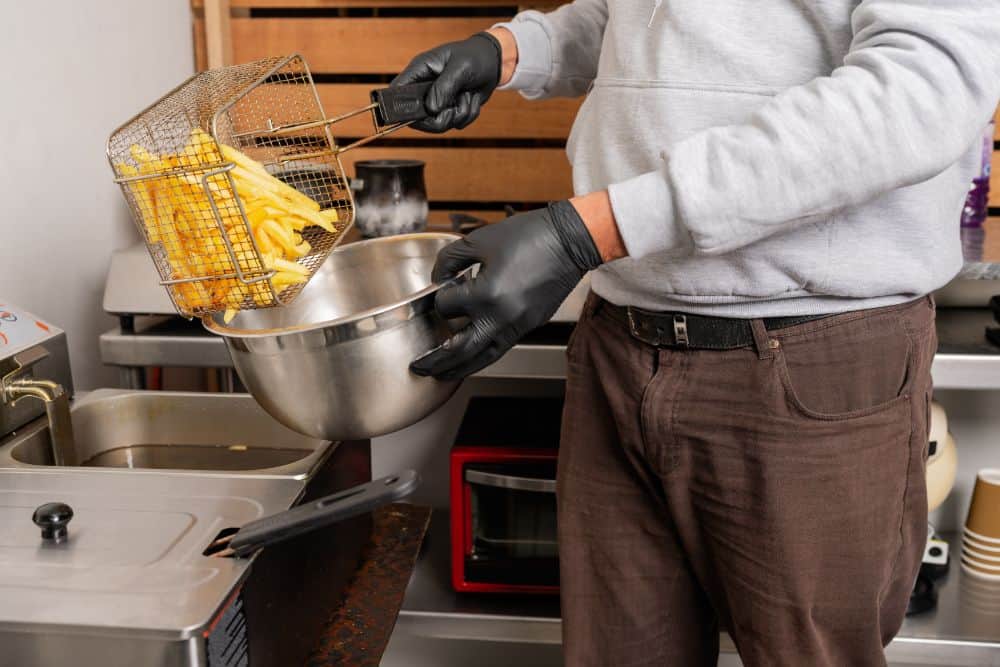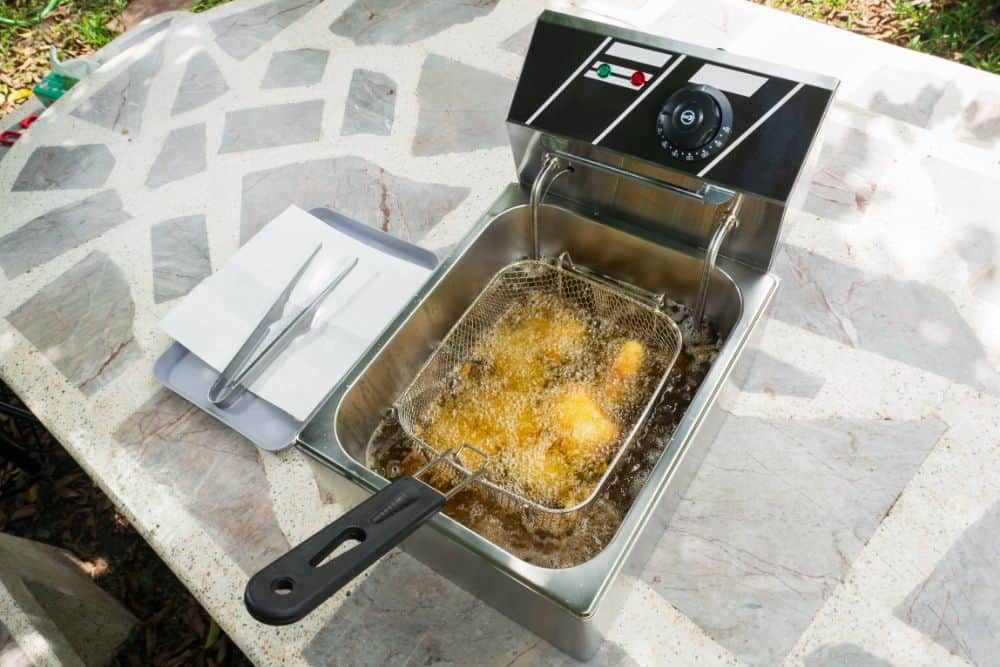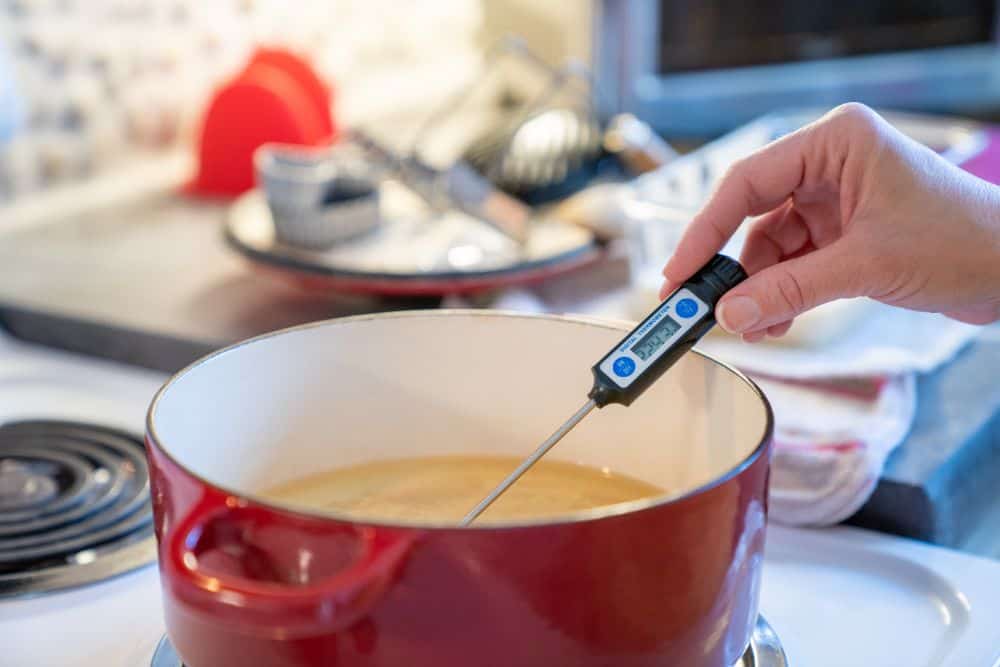Deep fryers and Dutch ovens are two cooking vessels that help home chefs create delicious fried foods that taste as if they came straight from a restaurant. These two tools can help develop restaurant-accurate meals, but there are a few differences.

With a Dutch oven or deep fryer, you can create savory treats like homemade bread, juicy fried chicken, and sweets like doughnuts or funnel cake.
Read on to learn the basics of deep fryers and Dutch ovens and the similarities and differences between these two kitchen staples. We'll also cover some of the most frequently asked questions about Dutch ovens and deep fryers.
There are generally two types of deep fryers: commercial and domestic.
A commercial deep fryer is a type used in restaurant settings. These are typically quite large and built to hold a lot of oil to deep fry a large amount of food at once.
Two of the most common uses for commercial deep fryers are french fries and fried chicken, especially in fast-food restaurants that rely on these large, fast machines.
In addition, there are different types of commercial fryers to suit any restaurant's needs. French fries and fried chicken cook in a "basket fryer," where metal wire baskets can be filled, dropped into the oil to cook, and quickly brought back up.

However, restaurants with different needs may require another type, such as a doughnut fryer which allows the dough to float on top of the oil rather than being dropped in a basket.
A domestic deep fryer holds less oil and handles far less food than the commercial type. This type of deep fryer is what you'll find in homes for personal use. It allows home chefs to create complex dishes with a regular stock pot full of oil.
These deep fryers can create french fries, fried chicken, and doughnuts, just like you might order from a restaurant.
A Dutch oven may appear to be a simple pot to the unacquainted. In reality, a Dutch oven consists of enameled cast iron. Because of its composition, a cast iron Dutch oven is quite heavy. This heaviness is one of the key features, as it ensures that temperature distribution stays even and steady during cooking.
The even temperature distribution and the tight-fitting lid give it the "oven" moniker. A Dutch oven can maintain and distribute heat similarly to a convection oven, though on a smaller, more concentrated scale.

A Dutch oven is often used for slow cooking, where food cooks at a low temperature for an extended amount of time. Many people use an instant pot for slow cooking recipes, but a Dutch oven is often preferred by those who compare the two.
Many believe the best Dutch oven is Le Creuset, a famous name in the kitchen world. Le Creuset is nearly synonymous with the Dutch oven, and many people use the two phrases interchangeably. However, for those on a budget there are more affordable options beyond the Le Creuset Dutch oven.
Dutch ovens and deep fryers can both be used to deep fry foods, but there are some critical differences between frying with these two appliances.
Ease of Use
A deep fryer is easier to use than a Dutch oven, especially for beginners. The process of using a deep fryer typically consists of adding oil, waiting for the fryer to reach your set temperature, and cooking your food for as long as you need. A thermometer is standard for domestic deep fryers, and it lets you know precisely when to lower your basket of food to fry.
A Dutch oven is slightly more complicated because it takes a little more know-how. With a deep fryer, you can essentially push a button and lower the basket, and you'll turn out evenly fried food every time.
With a Dutch oven, you need to acquire a thermometer (a candy thermometer works best) and carefully monitor the Dutch oven and temperature while frying. The food will need to be placed in and removed from the oil by you unless you purchase a frying basket meant for a Dutch oven.
A deep fryer will require less time than a Dutch oven when frying. This is because domestic deep fryers reach high temperatures quickly and will typically alert the user when it's at the set temperature.
A Dutch oven will heat up slowly compared to a deep fryer, and you must manually check the temperature of the oil using a candy thermometer. You may need to adjust your stove's heat until the thermometer reads a consistent oil temperature.
In addition, Dutch ovens will retain heat for far longer than a deep fryer. The deep fryer does include added time because it is a bit harder to clean than a Dutch oven. You must ensure your deep fryer is running efficiently by consistently cleaning the parts which come into contact with oil.
A deep fryer can fry a good amount of food at once. With a Dutch oven, frying size varies depending on the size of your specific appliance. Dutch ovens can be as small as a soup bowl or hold as much as 15 quarts of liquid. The main difference in size with Dutch ovens is the price, as huge Dutch ovens are pretty expensive.
The most popular sizes of Dutch ovens are five and a half quarts and six and three-quarter quarts. The standard size for domestic deep fryers is around 3 quarts. So a Dutch oven is generally capable of frying a more considerable amount at once. If frying a large serving in a deep fryer, you may need to do it in batches rather than all at once.
A deep fryer has a narrow scope as far as what it can make. However, a Dutch oven is a very versatile appliance. With a deep fryer, you can deep fry all sorts of things (such as fries, chicken, doughnuts, or fritter), but it is limited to deep-frying only.
A Dutch oven can be used for a wider variety of dishes, including but not limited to:
Here are some frequently asked questions about the similarities and differences between deep fryers and Dutch ovens.
You can use a deep fryer as a substitute for a Dutch oven ONLY if you are frying food. A deep fryer will not be suitable for some common uses of a Dutch oven, such as slow cooking, searing, or roasting.
If you are in need of a substitute for a Dutch oven for recipes that involve searing or roasting, a cast iron pan would be the best substitute. If you need a replacement for a Dutch oven for a slow cooker recipe, an Instant Pot or other slow cooker appliance will be the best substitute.
You can fry any meat in a Dutch oven. You can both deep-fry and pan-fry any type of meat using a Dutch oven.
In the cooking world, Dutch ovens are hailed as the sort of holy grail appliance. Why is this? The main reason for the praise is the Dutch oven's versatility. A Dutch oven can be used as a deep fryer, a cast iron pan, a bread oven, and a slow cooker. All these different uses make it a staple of many kitchens, as there aren't many single appliances that can cover so much ground.
The other main reason Dutch ovens get praise is that they are excellent when it comes to temperature consistency. An issue many home chefs have is that pans can unevenly cook, sear, or fry food. The reason for this is usually the thinness of the pan, which cannot evenly distribute the stovetop heat.
However, the cast iron and enamel layers of a Dutch oven make it a perfect heat vessel. A Dutch oven can get exceptionally hot, retain the heat for an extended period, and evenly distribute the heat within the pot.
Deep frying is an ideal cooking method for cast iron pots and Dutch ovens, as cast iron is the best "cooking metal" for heat retention. Dutch ovens are cast iron with an enamel layer on the outside, so they are perfectly capable of deep-frying at relatively high heat while having the added benefit of increased heat retention because of the extra enamel layer. This enamel coating also helps to protect the underlying cast iron from degrading from rust.
When deep-frying, ensure you use an oil with a high smoke point, such as avocado oil, canola oil, or corn oil.
If you would like to fry foods without the heaviness of oil, consider using an air fryer. With air frying, you can get the crispy crust texture and browning of deep-frying without using any oil.
